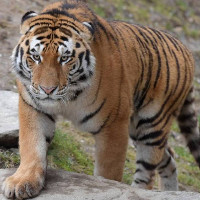 |
Siberian tiger |
|
He is a wild animal |
Origin |
Southeastern Russia and northern China | |
Translation |
Francis Vandersteen |
| The possession of this animal is not authorized Royal Decree establishing the list of mammals not kept for production purposes that may be kept (M.B. 24.08.2009) |
| The Siberian tiger generally has a larger, more massive body than the Bengal tiger, and wider legs; its height at the withers ranges from 100 cm to 120 cm, depending on the individual. Their claws measure around 10 cm. Siberian tigers weigh from 180 to 350 kg for males and 100 to 200 kg for females. The largest Siberian tiger, killed in 1950, weighed 384 kg. The Siberian tiger is the third largest terrestrial predator behind the Kodiak bear and the polar bear. Total body length including tail is between 2.7 and 3.8 m for males and between 2.4 and 2.75 m for females. Skull length is 341 to 383 mm for males and 279 to 318 mm for females. The coat has the particularity of having a summer coat and a winter coat. This feature was shared with the Caspian tiger, which disappeared in 1972. The winter coat is longer and thicker, almost shaggy and often lighter than the summer coat. In addition, a five-centimeter-thick layer of fat protects the belly and flanks from the cold. This is an evolutionary adaptation that enables it to withstand the extreme winter temperatures (down to -50°C) in its range, and to camouflage itself in the snow. In summer, on the other hand, its fur changes, becoming darker and finer, so that the Siberian tiger can easily withstand temperatures of up to +30° C and more, perfectly adapted to this extreme environment. One characteristic of the Siberian tiger is its very low genetic diversity, due to successive declines in the number of individuals of the subspecies. Despite its strength and keen senses, the Siberian tiger has to spend a lot of time hunting, and only succeeds in killing one out of ten times. Felines in general can go several days without eating, just long enough to capture a prey, then devour it over several days, gobbling up large quantities of food. In this case, the Siberian tiger can absorb up to 50 kg of meat in a single sitting, while sightings in India report 15-18 kg. It hunts mainly deer and wild boar. The Siberian tiger's only natural enemy is the brown bear, which sometimes attacks cubs or young. Several studies, notably by Russian specialists E.N. Matjushkin, V.I. Zhivotchenko and E.N. Smirnov in their book The Amur Tiger in the USSR, published in 1980 by IUCN, show that brown and Asiatic bears account for 5-8% of the Siberian tiger's diet, although the latter only enters into conflict in cases of great need, such as famine, as it prefers less dangerous prey. Generally speaking, bears tend to follow tigers to compete for their prey as scavengers. They can also swim for fish, but their morphology is better adapted to large prey. When they can, tigers choose to attack young, old or lame animals, which will have fewer reflexes and be slower, in order to facilitate the attack. It approaches to within 10-25 m of its prey before pouncing; small prey are killed by a bite to the neck, but large prey are knocked to the ground and suffocated by a bite to the throat. It hunts by stalking and stalking, preferring to ambush rather than pursue its prey. |






 English (United Kingdom)
English (United Kingdom)